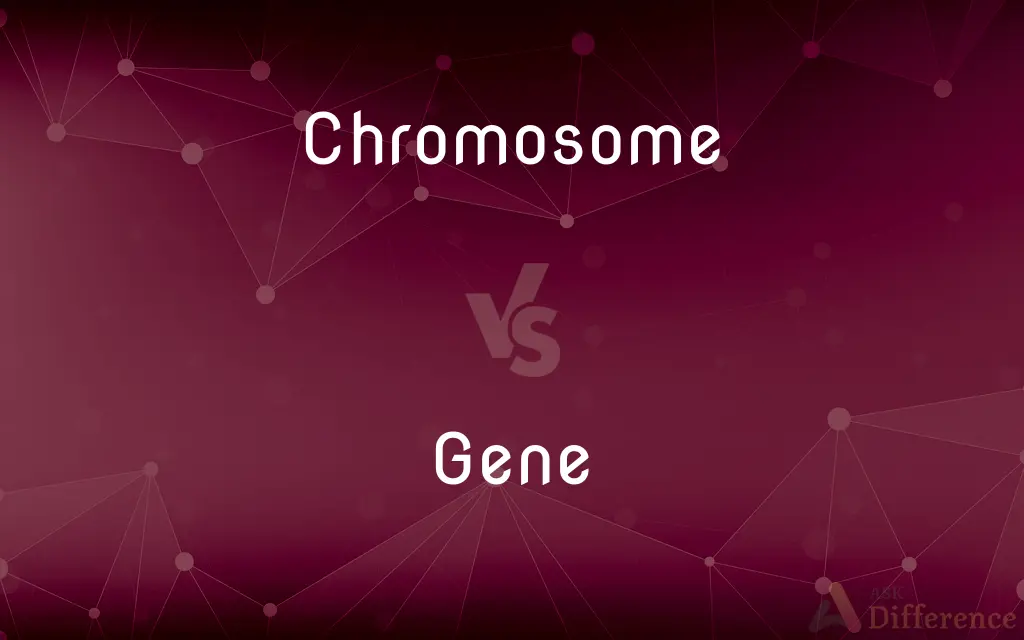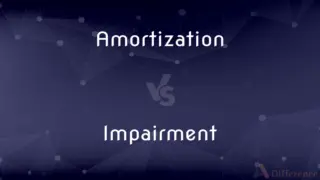Chromosome vs. Gene — What's the Difference?
By Tayyaba Rehman — Updated on September 15, 2023
A chromosome is a DNA molecule carrying genetic instructions, while a gene is a segment of DNA that encodes functional products like proteins.

Difference Between Chromosome and Gene
Table of Contents
ADVERTISEMENT
Key Differences
A chromosome is essentially a long thread-like structure made up of DNA, which contains the genetic instructions necessary for the development, functioning, and reproduction of living organisms. On the other hand, a gene is a specific segment or portion of this DNA that contains the necessary code to produce a particular protein or set of proteins, which have specific functions in the body.
The human genome, or complete set of genetic material, is organized into 23 pairs of chromosomes in every cell nucleus. These chromosomes are like libraries, housing vast amounts of information. Within these libraries, or chromosomes, are individual books, represented by genes, each holding a particular set of instructions.
It can be said that while chromosomes serve as the packaging and organization units for the genetic material, the genes represent the functional units, encoding the information required for various cellular processes. Each chromosome can have thousands of genes.
Finally, understanding the distinction between chromosomes and genes is foundational in genetics. A chromosome might be viewed as a chapter in a book, and the genes are like the sentences within that chapter, each conveying specific details and information.
Comparison Chart
Basic Definition
Thread-like structure of DNA
Segment of DNA encoding functional products
ADVERTISEMENT
Number in Humans
46 (23 pairs)
~20,000-25,000
Function
Organize & package genetic material
Encode specific proteins/functions
Size
Can be composed of hundreds of millions of DNA bases
Can vary from a few hundred to 2+ million DNA bases
Location
Found in the nucleus of cells
Located on chromosomes
Compare with Definitions
Chromosome
A thread-like structure of DNA that carries genes.
Humans have 23 pairs of chromosomes in each cell.
Gene
A DNA segment that codes for a specific protein or function.
The gene responsible for eye color can have variations leading to different hues.
Chromosome
Carries hereditary information in the form of genes.
Abnormalities in chromosome number can lead to genetic disorders.
Gene
Sequence of nucleotides in DNA determining a particular characteristic.
Scientists often study specific genes to understand their role in health and disease.
Chromosome
Organizational unit for genetic material.
Each chromosome is distinct and carries specific genetic information.
Gene
Region of DNA directing the production of a particular protein.
Through gene expression, genes can be turned on or off.
Chromosome
Complex of DNA and proteins forming a distinct structure.
During cell division, chromosomes ensure DNA is equally distributed.
Gene
Carrier of genetic information passed from parent to offspring.
Hereditary traits are often the result of specific gene combinations.
Chromosome
A chromosome is a long DNA molecule with part or all of the genetic material of an organism. Most eukaryotic chromosomes include packaging proteins called histones which, aided by chaperone proteins, bind to and condense the DNA molecule to maintain its integrity.
Gene
Basic physical and functional unit of heredity.
Mutations in a single gene can cause certain genetic disorders.
Chromosome
A linear strand of DNA and associated proteins in the nucleus of eukaryotic cells that carries the genes and functions in the transmission of hereditary information.
Gene
In biology, a gene (from genos (Greek) meaning generation or birth or gender) is a basic unit of heredity and a sequence of nucleotides in DNA or RNA that encodes the synthesis of a gene product, either RNA or protein.During gene expression, the DNA is first copied into RNA. The RNA can be directly functional or be the intermediate template for a protein that performs a function. The transmission of genes to an organism's offspring is the basis of the inheritance of phenotypic traits.
Chromosome
A circular strand of DNA in bacteria and archaea that contains the hereditary information necessary for cell life.
Gene
(in informal use) a unit of heredity which is transferred from a parent to offspring and is held to determine some characteristic of the offspring
Playing tennis is in my genes
Chromosome
A linear arrangement of condensed DNA and associated proteins (such as chaperone proteins) which contains the genetic material (genome) of an organism.
Chromosomes store genetic information.
Gene
A hereditary unit consisting of a sequence of DNA that occupies a specific location on a chromosome and is transcribed into an RNA molecule that may function directly or be translated into an amino acid chain. Genes undergo mutation when their DNA sequences change.
Chromosome
One of the minute bodies into which the chromatin of the nucleus is resolved during mitotic cell division; the idant of Weismann.
Gene
(genetics) A theoretical unit of heredity of living organisms; a gene may take several values and in principle predetermines a precise trait of an organism's form (phenotype), such as hair color.
Chromosome
A threadlike body in the cell nucleus that carries the genes in a linear order
Gene
(molecular biology) A segment of DNA or RNA from a cell's or an organism's genome, that may take several forms and thus parameterizes a phenomenon, in general the structure of a protein; locus.
A change in a gene is reflected in the protein or RNA molecule that it codes for.
Gene
(genetics) a segment of DNA that is involved in producing a polypeptide chain; it can include regions preceding and following the coding DNA as well as introns between the exons; it is considered a unit of heredity;
Genes were formerly called factors
Common Curiosities
Can chromosomes be seen under a microscope?
Yes, during certain stages of cell division, chromosomes can be visualized under a microscope.
What's the role of a gene?
A gene encodes instructions for making specific proteins or molecules that perform functions in the body.
What's the difference between a gene and an allele?
While a gene is a segment of DNA responsible for a specific trait, an allele is one of the different versions of that gene.
How many chromosomes do humans have?
Humans have 46 chromosomes, organized into 23 pairs.
How do chromosomes and genes play a role in inheritance?
Parents pass on combinations of their chromosomes, and therefore genes, to their offspring, determining inherited traits.
How do genes relate to traits?
Genes carry the instructions for traits, and variations in genes can lead to different expressions of those traits.
Are all genes active at all times?
No, genes can be "turned on" or "off" depending on various factors, including developmental stage and environmental signals.
What happens if there's an error in a chromosome?
Chromosomal abnormalities can lead to disorders like Down syndrome.
How do genes mutate?
Mutations can occur due to errors during DNA replication, environmental factors, or other causes.
Do all organisms have chromosomes?
Yes, all living organisms have chromosomes, though the number and structure can vary widely between species.
Share Your Discovery

Previous Comparison
Amortization vs. Impairment
Next Comparison
Alpaca vs. CamelAuthor Spotlight
Written by
Tayyaba RehmanTayyaba Rehman is a distinguished writer, currently serving as a primary contributor to askdifference.com. As a researcher in semantics and etymology, Tayyaba's passion for the complexity of languages and their distinctions has found a perfect home on the platform. Tayyaba delves into the intricacies of language, distinguishing between commonly confused words and phrases, thereby providing clarity for readers worldwide.
















































